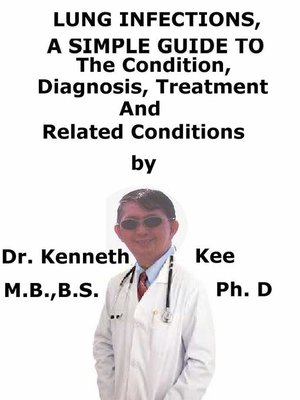Lung Infections, a Simple Guide to the Condition, Diagnosis, Treatment and Related Conditions
ebook
By Kenneth Kee

Sign up to save your library
With an OverDrive account, you can save your favorite libraries for at-a-glance information about availability. Find out more about OverDrive accounts.
Find this title in Libby, the library reading app by OverDrive.



Search for a digital library with this title
Title found at these libraries:
| Loading... |
This book describes Lung Infections, Diagnosis and Treatment and Related Diseases
Today we are fighting the COVID19 virus outbreak which is spreading through out the world as a Pandemic since December 2019.
There are now 179,073 cases of COVID-19 and at least 7,074 people have died, according to the most recent data (March 16 2020) from the WHO data.
This show the importance of a lung infection which produces symptoms same as the cold or flu, but may be more severe and normally last longer.
Severe symptoms of Lung infection are:
1. Difficulty breathing
2. A bluish color in the lips or fingertips
3. Severe chest pain
4. A high fever
5. Cough with mucus that is getting worse
The more frequent name for lung infection is a lower respiratory tract infection.
A person who is involved by such an infection tends likely to feel very weak and quite unwell.
It can be a precipitating factor for other health disorders.
A lung infection can be produced by a virus, bacteria, and occasionally even a fungus.
In the USA about 30% of pneumonias are viral.
A lung infection can be categorized as either chronic or acute.
When a diagnosis is made, it is normally of either bronchitis or pneumonia.
Bronchitis is most often produced by a viral infection, even though it can happen from the presence of bacteria.
On the other hand, pneumonia can happen from many different factors such as from the environment or a hospital infection.
This special lung infection is likely to involve people who have a weakened immune system like children, pregnant women or the elderly.
One of the most frequent types of lung infections is named pneumonia.
Pneumonia, which involves the smaller air sacs of the lungs, is most often produced by infectious bacteria, but can also be produced by a virus.
A person is infected by inhaling the bacteria or virus after an infected person sneezes or coughs.
When the large bronchial tubes that bring air to and from the lungs are infected, it is termed bronchitis.
Bronchitis tends more likely to be produced by a virus than by bacteria.
Viruses can also assault the lungs or the air passages that pass to the lungs.
This is named bronchiolitis.
Viral bronchiolitis most often happens in infants.
Lung infections like pneumonia are normally mild, but they can be severe, particularly for people with weakened immune systems or chronic disorders, such as chronic obstructive pulmonary disease (COPD).
Bronchitis, pneumonia, and bronchiolitis are the 3 types of lung infections.
They are normally produced by a virus or bacteria.
The most frequent microorganisms causing bronchitis are:
1. Viruses such as the influenza virus or respiratory syncytial virus (RSV)
2. Bacteria such as Mycoplasma pneumoniae, Chlamydia pneumoniae, and Bordetella pertussis
The most frequent microorganisms accountable for pneumonia are:
Bacteria such as Streptococcus pneumonia (most frequent), Haemophilus influenzae, and Mycoplasma pneumoniae
3. Rarely, lung infections can be produced by fungi such as Pneumocystis jirovecii, Aspergillus, or Histoplasma capsulatum.
A fungal lung infection is more frequent in people who are immunosuppressed either from certain types of cancer or HIV or from taking immunosuppressive medicines.
If the patient has a lung infection, the most frequent symptoms are:
1. Cough that produces thick mucus
2. Stabbing chest pains
3. Fever
4. Body aches
5. Shortness of breath
6. Crackling or rattling sounds in the lungs
A chest X-ray or CT scan may show...






